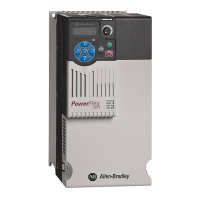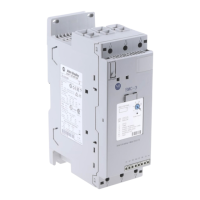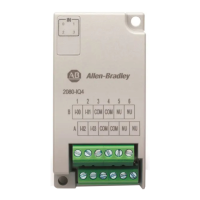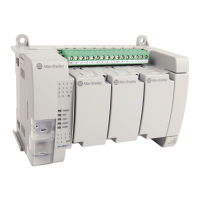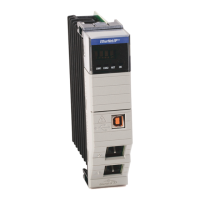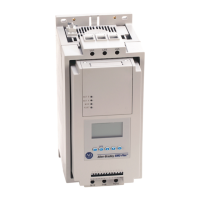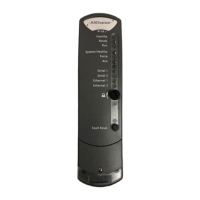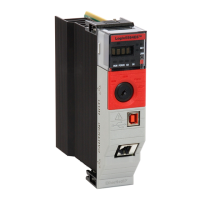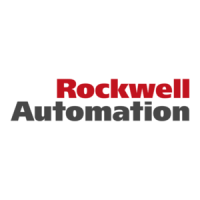




Do you have a question about the Rockwell Automation Allen-Bradley PowerFlex 700S and is the answer not in the manual?
| Amperage | 1.7...1742 A |
|---|---|
| Control Method | Vector Control |
| Communication Protocols | EtherNet/IP, ControlNet, DeviceNet, Profibus, Modbus |
| Enclosure Type | IP20, IP30, NEMA/UL Type 12 |
| Storage Temperature | -40...70 °C (-40...158 °F) |
| Relative Humidity | 5-95% (non-condensing) |
| Altitude | Up to 1000m (3280ft) without derating |
Lists changes made in the current revision of the manual.
Sets the rate at which the drive ramps up its output after a Start command.
Indicate conditions within the drive that could affect drive and application operation.
Handles input signals from analog sources like voltage or current.
Configures analog inputs for voltage or current signals and applies offsets and scaling.
Enables detection of analog input signal loss and defines drive reaction to it.
Configures output signals for voltage or current.
Programs analog outputs to specify the signal used and applies offsets, scaling, and limiting.
Key setup process for optimizing drive and motor performance.
Selects the motor control operating mode, such as FOC, PMag Motor, or V/Hz.
Selects the feedback device type for encoder or sensorless operation.
Manages bus voltage and dynamic braking capabilities.
Sets the carrier frequency for PWM output, affecting motor heating and noise.
Manages drive communication via networks and protocols.
Software connections to transfer I/O data and parameter values between devices.
Provides protection against overcurrent or overload conditions using various methods.
Configures and manages digital input signals.
Configures digital inputs for various functions like stop, start, or jog.
Configures and manages digital output signals.
Programs digital outputs for various functions like ready, running, or fault status.
Communication protocol for drive interaction and control.
Manages motor overload protection based on thermal characteristics.
Configures filters for tuning and performance optimization.
Used to compensate for system lags or eliminate noise in control loops.
Eliminates resonant signals created by mechanical gear trains.
Starts into a rotating motor in sensorless mode, resuming normal operation smoothly.
Calculates breakaway torque and torque needed to maintain constant speed due to friction.
Manages Human Interface Module (HIM) operations and display settings.
Configures the display shown when HIM keys are inactive for a predetermined time.
Provides step increments for motion control, often used with position loops.
Calculates torque required due to load inertia for smoother acceleration/deceleration.
Dictates overload capacitors and duty cycle based on current levels and time.
Software connections between parameters allowing information transfer.
Controls which ports/adapters have access to drive functions and parameters.
Selects the motor control method (e.g., FOC, PMag, V/Hz).
Selects FOC for AC induction motors, requiring motor data and autotune.
Manages motor overload protection based on duty cycles.
Provides safety guidelines for starting and stopping the motor.
Sets a limit tolerance to prevent the drive from exceeding a safe working speed.
Enables synchronization of drives for electronic line shaft applications.
Links to encoder position and specifies encoder edges per revolution.
Executes precise point-to-point motion moves using trapezoidal or S-curve profiles.
Executes trapezoidal or S-curve moves, allowing adjustments to acceleration/deceleration.
Allows a drive to follow the position of a master motor without an external controller.
Selects the auxiliary position reference for follower applications.
Adds correction moves to synchronize the follower to the master position.
Positions the load without an external controller using point-to-point moves.
Explains positioning the load without an external controller using point-to-point moves.
Provides motor coast, precharge, and auto-restart sequence during input power dropout.
Describes drive behavior during incoming power loss and return.
A control loop used to trim speed, torque, or other functions.
Compensates for inverter PWM pulses to reduce overvoltage transients at the motor.
Provides write access protection for individual communication ports in the drive.
Operates the motor without feedback, suitable for zero speed or limited speed range applications.
Adjusts output frequency to maintain consistent motor speed independent of load.
Selects and scales the feedback device signal for speed and position control.
Describes standard and optional encoder inputs for speed and position feedback.
Requires an MDI option card for position feedback, not speed feedback.
Details the Stegmann Hi-Resolution Encoder, Resolver, and MDI option cards.
Provides high-resolution encoder feedback for position and speed.
Manages the speed reference input for the speed control loop.
Selects the active speed reference source from digital inputs, DPI, or DriveLogix.
Sets forward and reverse speed limits for the speed reference.
Configures acceleration and deceleration times, with optional S-curve for smoother profiles.
Generates a smooth, noise-free virtual encoder reference for motion control.
Adjusts torque reference to maintain desired speed using proportional and integral gains.
Increases stiffness of speed response to load disturbances, acting like a position regulator.
Determines the proportional and integral gains for the speed regulator's response.
Provides steps for tuning the speed regulator, compensating for backlash or lost motion.
Selects the drive's operating mode: speed regulator, torque regulator, or combination.
Allows motor to be fully fluxed and ready to rotate, useful for cyclical applications.
Sets the drive to operate as a speed regulator, generating torque reference to maintain speed.
Controls motor torque to maintain tension or draw in processes like winders.
Compares speed and torque commands, using the algebraic minimum or maximum.
Forces speed regulator into saturation, following torque reference until breakage.
Enables finding the "Home" position without an absolute device or DriveLogix processor.
Configures drive start and stop control using 2-wire or 3-wire methods.
Provides information on SynchLink parameters and setup examples.
Selects and configures direct data words for SynchLink communication.
Performs multiplication and division on floating point parameters.
Enables or disables various user-configurable functions in the drive.
Compares words and replaces selected bits, used for custom control logic.
Motor operated potentiometer for increasing/decreasing DInt or floating point values.
Selects from multiple floating point or DInt values for preset speeds or other inputs.

